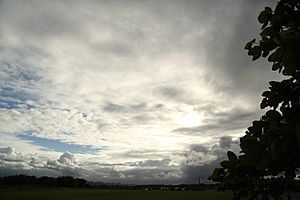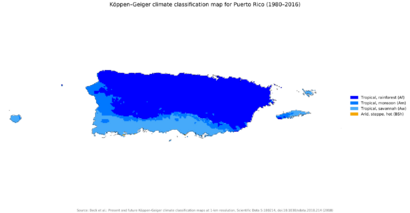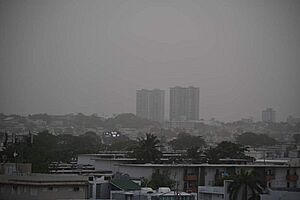Climate of Puerto Rico facts for kids
The climate of Puerto Rico is mostly a tropical rainforest type. This means it's warm to hot all year round. Temperatures usually average around 85°F (29°C) in lower areas and 70°F (21°C) in the mountains. Steady winds called trade winds blow across the island throughout the year. The rainy season lasts from April to November. The mountains in the middle of Puerto Rico, called the Cordillera Central, block these winds. This creates "rain shadows" and causes big changes in temperature and wind speed over short distances. About a quarter of Puerto Rico's yearly rain comes from big storms called tropical cyclones. These storms happen more often during La Niña years.
Contents
Temperature in Puerto Rico
Temperatures in lower areas of Puerto Rico usually range from 70°F to 90°F (21°C to 32°C). In the higher mountains, temperatures are cooler, staying between 61°F and 80°F (16°C to 27°C) all year. The southern part of the island is a bit hotter than the north. There isn't a huge difference in temperature between winter and summer, only about 6°F (3°C).
The warmest temperature ever recorded in Puerto Rico was 103°F (39°C) in San Lorenzo. The coldest was 38°F (3°C) in Aibonito. Sometimes, the highest mountains can even get frost or freezes.
| Climate data for Puerto Rico | |||||||||||||
|---|---|---|---|---|---|---|---|---|---|---|---|---|---|
| Month | Jan | Feb | Mar | Apr | May | Jun | Jul | Aug | Sep | Oct | Nov | Dec | Year |
| Record high °F (°C) | 98.1 (36.7) |
99.7 (37.6) |
99.5 (37.5) |
102.6 (39.2) |
104.0 (40.0) |
102.9 (39.4) |
104.7 (40.4) |
104.0 (40.0) |
103.1 (39.5) |
104.5 (40.3) |
98.6 (37.0) |
97.0 (36.1) |
104.7 (40.4) |
| Record low °F (°C) | 39.7 (4.3) |
39.6 (4.2) |
37.4 (3.0) |
43.2 (6.2) |
49.3 (9.6) |
50.0 (10.0) |
55.4 (13.0) |
55.6 (13.1) |
48.7 (9.3) |
45.9 (7.7) |
41.9 (5.5) |
40.1 (4.5) |
37.4 (3.0) |
| Source 1: Pogoda.ru.net - Climate Monitor — Meteo.ru - Baseline Climatological Data Sets | |||||||||||||
| Source 2: NOAA NCDC - Climate Data Online | |||||||||||||
Sahara Dust
Scientists have been studying dust that travels all the way from the Sahara Desert to Puerto Rico. They believe this dust causes changes in Puerto Rico's weather. It can make the sky hazy and increase the heat.
Wind Patterns
Steady winds, called trade winds, blow from east to west across Puerto Rico all year. These winds usually move at about 19 miles per hour (30 km/h). When the trade winds are lighter, local winds like sea breezes (from the ocean to land) and land breezes (from land to ocean) become more important.
Every few years, a hurricane brings very strong winds to the island. For example, when Hurricane Maria hit in 2017, it was so strong that it knocked out all the electricity across the entire island.
Rainfall in Puerto Rico
Puerto Rico has a clear rainy season from April to November and a dry season from December to March. Sometimes, the dry season can cause a drought. Because of the island's mountains and valleys, the amount of rain changes a lot from one place to another. Some areas get a lot of rain, while others get very little.
Severe Weather and Hurricanes
Puerto Rico is in the Atlantic hurricane season, just like other islands in the Caribbean. On average, about a quarter of the island's yearly rain comes from tropical storms and hurricanes. These storms are more common during La Niña years.
A tropical storm passes near Puerto Rico about every five years. A hurricane passes nearby, on average, every 11 years. Since 1851, two very strong Category 5 hurricanes have directly hit the island: the Lake Okeechobee Hurricane in September 1928, and Hurricane Irma in September 2017.
Sometimes, waterspouts (like tornadoes over water) form off the coast during thunderstorms. Tornadoes and hailstorms can also happen inland. These storms often form when tropical waves or cold fronts move across the region, especially between fall and spring.
- Hurricane Irma (2017): In September 2017, Category 5 Hurricane Irma passed very close to Puerto Rico. Its strong winds, up to 180 mph (290 km/h), caused a lot of damage. Even though the eye of the storm stayed offshore, its powerful outer part hit the northeastern side of the island, including San Juan. Nearly 70% of the island lost power. This storm greatly weakened the power grid and other buildings, making them more vulnerable to the next hurricane.
- Hurricane Maria (2017): Just two weeks after Irma, Hurricane Maria hit Puerto Rico on September 20, 2017. It was a very strong Category 4 hurricane with winds of 155 mph (250 km/h). Heavy rain caused widespread flooding, with some areas in San Juan having waist-deep water. Many buildings lost their roofs.
About 80% of the island's farms and crops were destroyed, costing around $780 million. The hurricane completely knocked out the island's power grid, leaving all 3.4 million people without electricity. Hurricane Maria caused a huge crisis in Puerto Rico, with damages estimated at $90 billion and a tragic loss of nearly three thousand lives.
Weather by Season
Wet Season (April to November)
The wet season is hot and humid. Thunderstorms often happen in the afternoons, especially in August and September. The trade winds bring cooler breezes to the north and east of Puerto Rico. However, because of the mountains, these winds don't reach the south and west coasts. This makes those areas much hotter. On humid summer days, it can feel as hot as 115°F (47°C), and actual temperatures can reach 100°F (38°C).
June is usually the driest month of the summer. During June and July, most of the rain comes from the island's heat and humidity. The peak of hurricane season is in September. During this time, the weather can be very rainy with frequent, strong thunderstorms as tropical storms pass nearby. By early November, the hurricane season ends, and the weather becomes drier and sunnier.
Dry Season (December to March)
The dry season brings cooler, less humid weather. Weak cold fronts from the north cause temperatures and humidity to drop. Sunny and dry conditions are common. In San Juan during winter, high temperatures are usually around 77–87°F (25–30°C). Low temperatures are around 66–76°F (19–24°C).
In the central mountains, temperatures are cooler because of the higher elevation and less influence from the sea. Minimum temperatures average 55–65°F (13–18°C). After a cold front passes, mountain temperatures can drop to the 40s (4–9°C). Valleys might see temperatures in the 50s (10–15°C), and coastal areas in the low 60s (16–20°C). Overall, the dry season is sunny and pleasant, with little change day to day. February and March are often very dry, sunny, and hot.
Sunlight
The sun rises between 5:30 a.m. in summer and 7:00 a.m. in winter. It sets between 5:40 p.m. in winter and 7:10 p.m. in summer. Puerto Rico does not use daylight saving time. The ultraviolet (UV) index, which measures how strong the sun's rays are, is usually 10+ in the summer and a maximum of 7 in winter.






